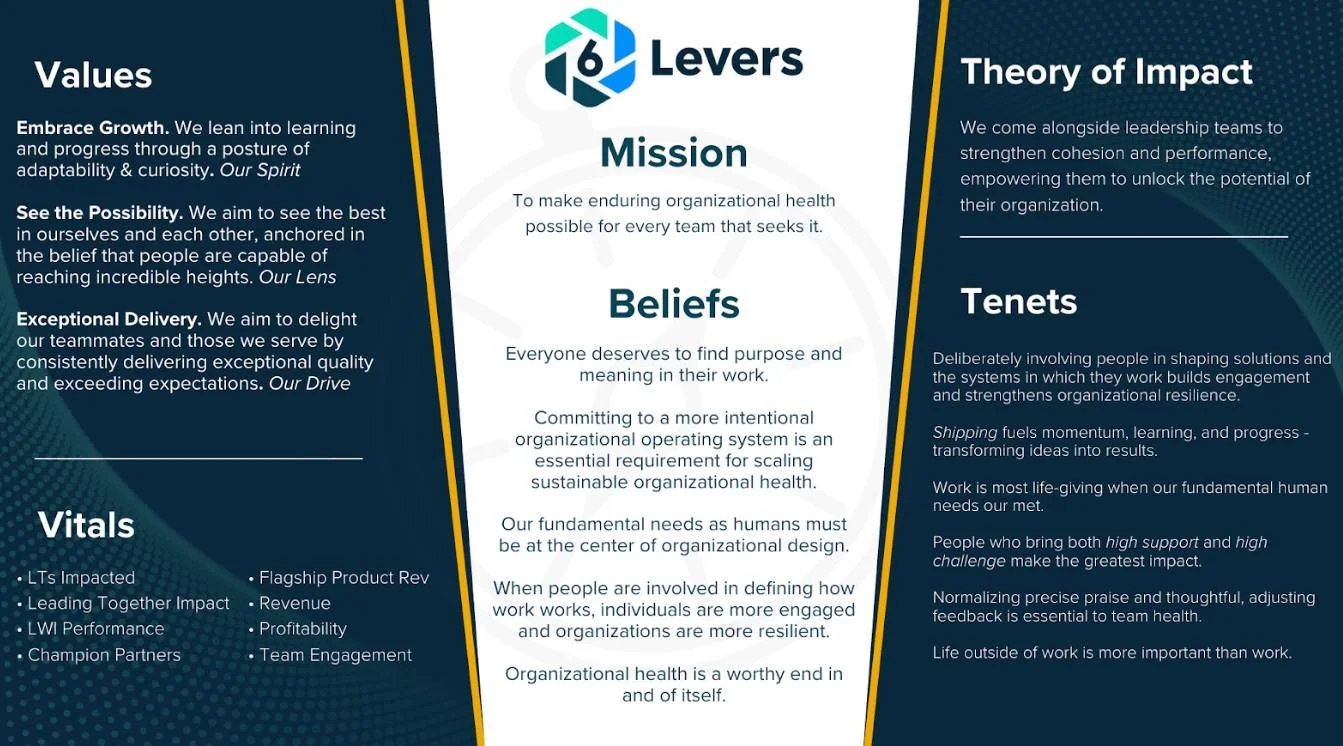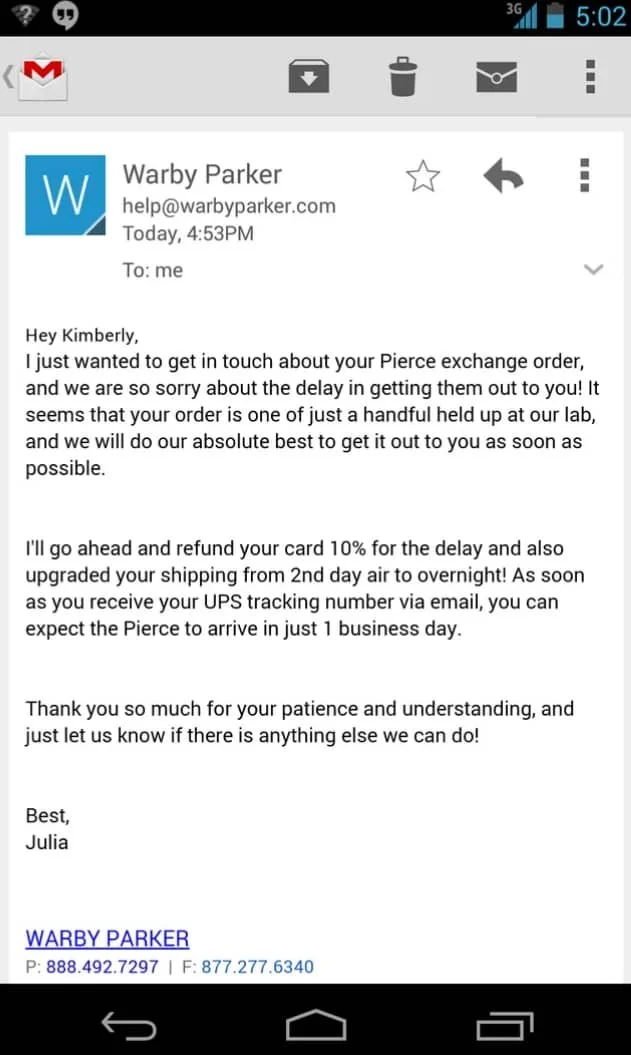The Surprising Thing That Anchored Warby Parker’s Growth
What would you trade for more meaningful work? A 2018 Harvard Business Review study found that 9 out of 10 people would trade over 20% of their lifetime earnings for greater sense of meaning at work.
Why would people be willing to make that trade? As one CEO we work with closely put it, “it’s the difference between a job and a career.” A job is something you endure to get through the week; a career is something that fuels you and grows you. When meaning is absent, people go home drained, wondering if what they did mattered. But when meaning is present, work becomes a source of energy, growth, and pride - the kind of work that sustains people far more than a paycheck ever could.
People are hungry for meaningful work. But most teams are operating in ways that don’t appreciate just how important this fundamental human need is. Feeling a sense of genuine meaning at work is essential, and it’s something every team can design for.
What It Looks Like When Teams Lack Meaning
Most people don't walk around saying, "I wish I had more meaning at work." But the signs of low meaning are everywhere and they’re costly.
Here’s what it often looks like. The signals below don’t prove that a lack of meaning is the only issue, but they’re often overlooked clues it may be a contributing factor.
Quiet rooms: In meetings, only a few voices dominate while most stay silent. Energy dips, ideas go unsaid, and participation shrinks.
Low ownership: Tasks are completed, but few people are thinking about how to make things better, completing no more than the exact task at hand. Initiative is rare.
Potential/performance gap: You see people with strong capability but inconsistent output. Talent is present, but it’s untapped, a common sign that drive and meaning aren’t fueling performance.
None of these issues show up on a dashboard labeled “meaning gap,” but they’re often symptoms of it. When teams can’t connect their daily work to something they care about, and believe in, performance suffers. But more importantly, people suffer. They go home drained. They question whether it’s worth it. They lose their spark.
To Scale Meaning, Start by Clarifying your Identity
To increase a sense of meaning and purpose, a good place to start is by defining your identity more holistically. Consider these six components below and whether defining any of them would help establish a foundation of meaning to then activate across your organization.
Beliefs: The deep convictions that explain why you are committed to your mission. They expand upon a mission statement offering a more complete picture of your why.
Mission: Your reason for existing, the aspirational forever objective you will always be pursuing.
Theory of Impact: How you believe you uniquely accomplish your mission. This is the beginning of your strategy.
Values: The specific behaviors you expect to see in your people
Tenets: The operational principles that shape your systems and culture
Vitals: The most important measures of success - just the most essential 5-7
6 Levers' Compass: A strategic orientation tool that clarifies your team’s Identity
Meaning doesn’t scale by accident, it scales through clarity. When your organization’s Identity is clearly defined, it becomes easier for every team member to see how their role contributes to something larger and purposeful. Decisions become more aligned, culture becomes more consistent, and strategy becomes more grounded. If you want to build a culture where people can find meaning in their work, start with Identity. Define what you believe, why you exist, how you create impact, and what success truly looks like. Because the more clearly you define who you are, the more meaningfully your people can show up.
Warby Parker: Identity in Action
Warby Parker is an online retailer founded in 2010, offering designer-quality prescription glasses, sunglasses, and contact lenses at affordable prices, along with eye exams and vision tests. The company was founded to address high eyewear prices by designing and selling frames directly to consumers, and it operates with a "Buy a Pair, Give a Pair" program, donating a pair of glasses to someone in need for every pair sold.
They are a rare example of a company that didn’t just define its Identity, it built systems to activate it with the intention of making work meaningful. From day one, their mission has been clear: "To inspire and impact the world with vision, purpose, and style." But what stands out isn’t just the words. It’s the way they’ve designed work to make the mission real.
Their values are tangible. Phrases like "Learn. Engage. Repeat." show up in their onboarding processes, not just on the website.
Their business model reflects their beliefs. The "Buy a Pair, Give a Pair" program isn’t a marketing campaign. It’s a built-in mechanism for social impact, and over 10 million pairs of glasses have been distributed as a result.
Their culture is intentionally designed. Onboarding is immersive and cross-functional. As an example of this, the founders hold a weekly all-hands meeting that still includes open contributions from anyone in the company.
Their systems reinforce meaning. They host an open library to reflect their belief in continuous learning. They run weekly Happiness Pulse surveys to track engagement and culture. They make space for innovation at every level.
In just eight years, Warby Parker scaled to 1,400 employees. But they did it without sacrificing their unique identity. That’s the power of Identity when it’s not just defined - it guides and in doing so leads to even greater success. By intentionally defining their identity and then using it as a compass to shape their systems and culture, they empower people to show up like this customer service team member did in the message below:
How to Activate Meaning on Your Team
You don’t have to be a brand like Warby Parker to design more meaningful work. You just need intention. Here are three ways to start:
1. Create a Compass
A Compass is a strategic orientation tool that clarifies your team’s Identity. It includes your beliefs, mission, theory of impact, values, tenets, and vitals. It’s a living reference point that orients your team, keeps strategy aligned to purpose, and creates a shared language for what matters most. If you want a roadmap for meaning, start here.
2. Tell Stories of Meaning in Action
Stories make abstract values real. Invite team members to share moments when their work felt meaningful or deeply connected to the mission. These stories help uncover where Identity is already showing up and inspire others to find meaning in their own roles.
3. Design Identity into Your Systems
Use existing processes to reinforce meaning. Add a values-alignment question to hiring rubrics. Use beliefs as a filter when setting priorities. Incorporate reflection prompts into retrospectives that ask how the work connected to your mission. Systems are the infrastructure of culture. Make sure they reflect what you stand for.
Final Thought
Your people don’t want to be managed toward results. They want to be part of something that matters. When Identity is clear and activated, it brings teams together around purpose. It deepens engagement. It increases autonomy. And it creates the kind of trust and ownership that fuels real performance.
It’s not just about having a mission. It’s about knowing who you are, and making that accessible and easily understood to everyone in your organization.
- Shaun & Joe



